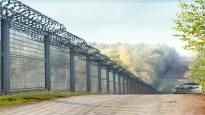Building border fences has become a trend all over the world. Back when the Berlin Wall fell, fences and walls were quite rare.
Johanna Laakkonen,
Sampo Vaarakallio
A fence is being built on the border between Finland and Russia, the purpose of which is to make it difficult for unwanted people to cross the border. The matter was discussed in Parliament yesterday, and all parties supported the border fence.
The Border Guard has already said that the fence is necessary and presented plans for its construction.
The physical fence is justified by the fact that it would make border surveillance more effective in the event of disturbances.
In practice, a disruptive situation could mean, for example, that Russia would mechanize the transport of migrants to the border. There have been experiences of similar political pressure in Europe, when Belarus moved migrants to the borders of Poland and Lithuania a year ago.
According to the current plans, the fence would not cover the entire eastern border, but would cover 10–20 percent of the border. The fence would rise for a maximum of about 260 kilometers on the approximately 1,300 kilometer long border.
In this article, we will tell you what is known about the fence now, how the construction of border fences has affected other parts of the world, and why it is not just a physical barrier in Finland.
For the story, a professor who studied borders has been interviewed Jussi Laineta from the University of Eastern Finland, frontier researcher Anssi Paas from the University of Oulu and social relations manager of the Finnish Refugee Agency Katja Mannerström.
A fence several meters high would be monitored with the help of technology
The plan is to first build a test fence a few meters long at the border near the busiest border stations in Southeast Finland. The Border Guard has not said exactly what kind of fence it would be.
The Border Guard has estimated that the construction of the entire fence will take 3–4 years and cost hundreds of millions of euros.
It is known that the fence would be several meters high and there would be a barbed wire barrier on top of it, which would prevent crossing the fence. In addition, the entire area of the fence would be subject to technical supervision.
The so-called trial fence would be three kilometers long and would cost six million euros. The project starts when the government decides on its financing.
According to the Border Guard, the test fence could be completed by next summer, but the actual fence project could still be started right away.
The fence does not prevent people from passing
Border fences do not completely prevent people from moving, but it may slow it down. According to experts interviewed by , there is experience in other parts of the world that building fences increases insecurity when people use dangerous routes or ways to cross the border.
Even if unwanted entry could be curbed with a fence, according to experts, it would cause more harm than good. A border fence usually increases crime at the border. Immigrants and refugees have to travel long distances because of the fence and are easy victims of robberies or other crimes.
At Europe’s fenced borders, the dark business runs strong, when criminal organizations help people cross the border illegally at a high price. In the worst case, people die trying to cross the border.
Symbolic meaning
The construction of the border fence has a particularly symbolic meaning. According to experts, the border fence answers people’s fear of what might happen on the eastern border in the future.
According to experts, people’s attitude towards the border fence has turned into a pessimism quite quickly. The discussion really started only a year ago, after Belarus machined migrants to the borders of Poland and Lithuania.
In Finland, it has been feared that Russia could act in the same way on our border. This has caused fear, which according to experts is completely understandable, because Russia has turned into a very unpredictable neighbor.
The border fence also wants to create a psychological sense of security. Finland has a border with Russia of about 1,300 kilometers, so according to experts, fencing off a few hundred kilometers does not really hinder movement.
Fencing borders is a new trend
The fencing of borders is, after all, a new phenomenon. In the whole world, after the Second World War, only seven borders were fenced. When the Berlin Wall fell, 15 borders were fenced off. In 2018, 80 borders were already fenced.
For Europe, fencing borders has been a major security policy issue. The desire to fence off the continent has also stemmed from guaranteeing financial security. Immigrants do not want to share the cake of European prosperity.
It is worth noting that they also want to get rid of border fences. Slovenia is currently dismantling the fence on its border with Croatia. The country’s government justifies its decision on human rights grounds. It doesn’t want any more people dying on its borders.
The video below explains how migrants are increasingly used as leverage in political disputes between states. The video has been published in autumn 2021.
What do you think about the border fence? The discussion on the topic is open until 23:00 on October 20.
